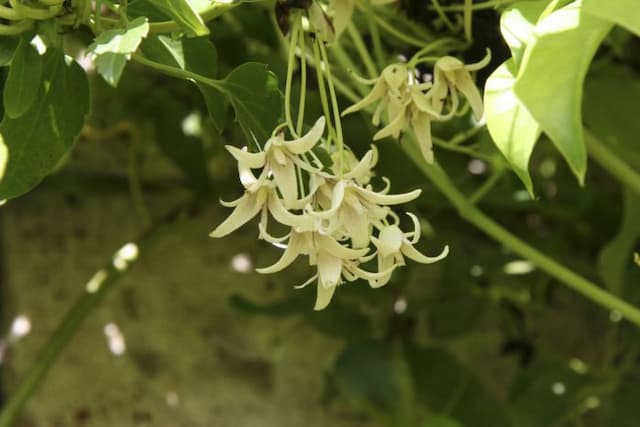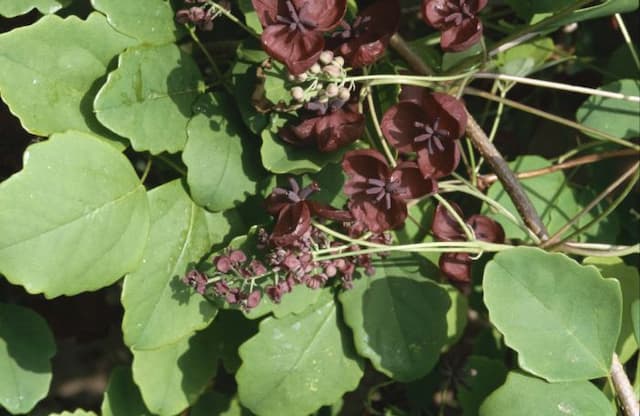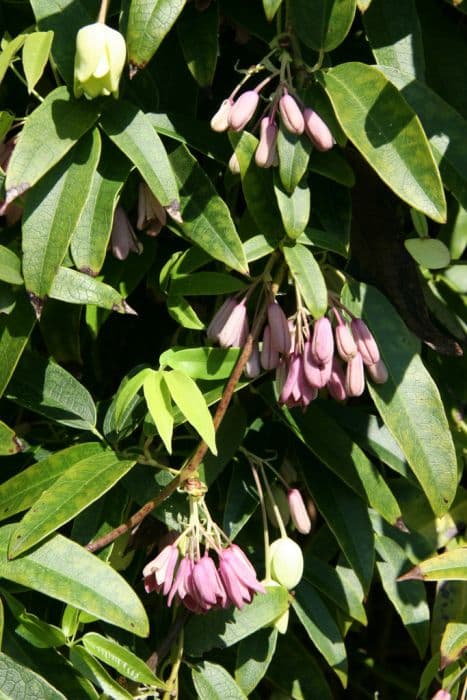Dead Man's Fingers Decaisnea fargesii

ABOUT
The plant commonly known as Dead Man's Fingers is an unusual and eye-catching species that garners attention for its striking features. This deciduous shrub is notable for its pinnate leaves which are elongated and arranged in a feather-like pattern. The foliage emerges as a bright light green in the spring and transitions into a lush dark green as the seasons progress, offering a vivid backdrop for its other distinctive characteristics. One of the most remarkable traits of Dead Man's Fingers is its fruit, which takes on an almost otherworldly appearance. The fruits are elongated, fleshy pods that somewhat resemble fingers, hence the common name. They typically present a remarkable blue or bluish-silver color at maturity, which is quite rare in the plant kingdom, creating a striking visual contrast against the foliage. Flowers of Dead Man's Fingers are less conspicuous when compared to its unusual fruit. They emerge in early summer, forming clusters that dangle elegantly from the branches. The flowers carry soft yellowish-green hues and are bell-shaped, providing a subtle but beautiful display. Dead Man's Fingers is also recognized for its bark, which has a fetching greenish hue when young, becoming more brown and rough with age, adding to the textural interest of the plant throughout the year. In essence, Dead Man's Fingers provides a blend of fascinating colors and shapes, from its leafy green foliage and curious fruit to its delicate flowers and textured bark, contributing to its status as a conversation piece in any garden where climate conditions are suitable for its growth.
About this plant
 Names
NamesFamily
Lardizabalaceae
Synonyms
Dead Man's Fingers, Blue Sausage Fruit, Blue Bean Plant
Common names
Decaisnea fargesii Franch.
 Toxicity
ToxicityTo humans
Dead Man's Fingers (Decaisnea fargesii) is not known to be toxic to humans. In fact, the fleshy blue fruit is considered edible and has been consumed, particularly in some Asian cultures. However, as with any plant, individual allergies or sensitivities can occur, so it’s always wise to be cautious when trying a new plant for the first time. If unusual symptoms arise after ingestion, medical attention should be sought.
To pets
Dead Man's Fingers (Decaisnea fargesii) is also not specifically known to be toxic to pets. While the fleshy fruit is generally considered edible for humans, caution should be exercised when pets are involved, since their digestive systems and reactions can differ from ours. If a pet ingests parts of the plant and shows signs of distress such as vomiting, diarrhea, or unusual behavior, it is advisable to consult a veterinarian.
 Characteristics
CharacteristicsLife cycle
Perennials
Foliage type
Deciduous
Color of leaves
Green
Flower color
Yellow
Height
15-20 feet (4.6-6 meters)
Spread
8-12 feet (2.4-3.7 meters)
Plant type
Shrub
Hardiness zones
6
Native area
China
Benefits
 General Benefits
General Benefits- Ornamental appeal: Decaisnea fargesii, commonly known as dead man's fingers, is valued for its unique blue fruit pods and vibrant yellow autumn foliage, making it an intriguing addition to gardens.
- Wildlife attraction: The shrub provides food in the form of its fruits for birds and other wildlife, supporting biodiversity.
- Minimal maintenance: It is a hardy plant that requires little care once established, suitable for gardeners who prefer low-maintenance plants.
- Drought resistance: Dead man's fingers can tolerate periods of dryness once established, making it suitable for xeriscaping or gardens in drier climates.
- Architectural interest: With its distinctive shaped leaves and fruit, the plant adds architectural interest to garden designs or as a specimen plant.
 Medical Properties
Medical PropertiesThis plant is not used for medical purposes.
 Air-purifying Qualities
Air-purifying QualitiesThis plant is not specifically known for air purifying qualities.
 Other Uses
Other Uses- Dead man's fingers, the common name for Decaisnea fargesii, can be used as an ornamental plant in gardens for its unique and intriguing blue fruit pods that resemble human fingers.
- The seeds inside the fruit of dead man's fingers are sometimes used as beads in jewellery because of their hard coating and attractive appearance once polished.
- Dead man's fingers can serve as a conversation piece or educational tool in botanical gardens due to its unusual appearance and the way it can spark interest in plant diversity and morphology.
- The pulp of dead man's fingers is occasionally used as a natural dye for fabrics, giving a subtle color when treated appropriately.
- Photographers and artists might utilize dead man's fingers as a subject in their work, capturing its unique beauty and macabre aesthetic.
- In specialty culinary contexts, the clear, jelly-like fruit pulp of dead man's fingers may be experimented with as an exotic food ingredient, although it is not widely consumed.
- During Halloween, the fruit pods are sometimes incorporated into thematic garden displays or used as part of costumes due to their eerie appearance.
- Dead man's fingers can be used in educational settings, such as biology classrooms, to discuss fruit development and seed dispersal strategies.
- The leaves and growth habit of dead man's fingers provide a lush, tropical look that can be incorporated into garden designs that aim to create an exotic escape.
- Horticulture enthusiasts might graft dead man's fingers onto related species for experimental purposes to study hybridization effects or propagation techniques.
Interesting Facts
 Feng Shui
Feng ShuiThe Dead Man's Fingers is not used in Feng Shui practice.
 Zodiac Sign Compitability
Zodiac Sign CompitabilityThe Dead Man's Fingers is not used in astrology practice.
 Plant Symbolism
Plant Symbolism- Mystery: Decaisnea fargesii, commonly known as Dead Man's Fingers, produces unusual blue fruit pods that are slightly eerie in appearance, invoking a sense of the mysterious and otherworldly.
- Uniqueness: The plant's distinctive fruit and overall unique appearance symbolize the celebration of individuality and the beauty of standing out from the crowd.
- CURIOSITY: Dead Man's Fingers, with its peculiar-looking fruits, piques the interest of gardeners and passersby, symbolizing a thirst for knowledge and the joy of discovery in the natural world.
 Water
WaterBlue bean shrub prefers consistent moisture but requires well-draining soil to prevent root rot. During the growing season, water the plant thoroughly once a week with approximately 1 gallon of water, ensuring the soil is moist but not soggy. In hot, dry weather, check the soil moisture level more frequently and water as needed. During winter or dormancy, reduce watering to every two to three weeks, depending on the soil's dryness. Always adjust your watering frequency based on rainfall, humidity, and soil conditions to avoid overwatering.
 Light
LightBlue bean shrub thrives in full sun to partial shade. The ideal spot for this plant would be a location where it receives at least 4 to 6 hours of direct sunlight each day, with some dappled shade to protect it from the harsh midday sun. Avoid deep shade as this can hinder the plant's growth and fruit production.
 Temperature
TemperatureBlue bean shrub is hardy and can tolerate a wide range of temperatures. It grows best within a temperature range of 60°F to 75°F. The plant can survive winter temperatures down to around 5°F but should be protected from harsh cold winds. Ideal growing conditions do not typically exceed 85°F during the hottest months of the year.
 Pruning
PruningPrune blue bean shrub to maintain shape and remove any dead or damaged branches, which promotes healthier growth and air circulation. Pruning should be done in late winter or early spring before the new growth starts. The shrub does not require heavy pruning; simply thin out older branches and cut back any overgrowth to encourage a bushier plant.
 Cleaning
CleaningAs needed
 Soil
SoilDead Man's Fingers prospers in moist, well-draining soil with a pH range of 6.0 to 6.5. A good mix would be loamy soil with organic compost and perlite to enhance drainage and aeration.
 Repotting
RepottingDead Man's Fingers should be repotted every 2-3 years to prevent becoming root-bound and to refresh the soil.
 Humidity & Misting
Humidity & MistingDead Man's Fingers thrives in moderate humidity levels and does not require any special humidity considerations beyond what is typically found in its outdoor environment.
 Suitable locations
Suitable locationsIndoor
Place Dead Man's Fingers in bright, indirect light indoors.
Outdoor
Plant Dead Man's Fingers in partial shade outdoors.
Hardiness zone
6-9 USDA
 Life cycle
Life cycleDecaisnea fargesii, commonly known as Dead Man’s Fingers, begins its life cycle as a seed which germinates in moist soil conditions in spring. The emergent seedlings then develop into juvenile plants with a moderate growth rate, forming a shrub-like structure and producing pinnate leaves. As the plant matures, it develops into a small to medium-sized deciduous shrub or tree, reaching maturity at approximately 4-6 years. Upon reaching reproductive maturity, Decaisnea fargesii produces pendulous clusters of small, yellow-green flowers in late spring to early summer. Following pollination, it bears distinctive blue fruit pods resembling fingers in late summer to autumn, which contain black seeds dispersed by gravity or animals. The plant continues this reproductive cycle yearly, with a lifespan that can extend several decades in the right growing conditions.
 Propogation
PropogationPropogation time
Spring to early summer
Decaisnea fargesii, commonly known as Dead Man's Fingers, is best propagated through seeds. Planting should occur after the last frost, typically in early spring. To propagate, collect ripe blue seed pods in late summer or early fall and extract seeds. Clean seeds should be sown about 1/2 inch deep (approximately 1.3 centimeters) in well-drained potting mix and kept at room temperature. Germination can be erratic, often taking several weeks to months. Once seedlings have developed a few sets of true leaves, they can be potted on or, weather permitting, planted out in a semi-shaded to sunny location in the garden. Careful attention to watering and protection from extreme conditions will establish a strong plant that can eventually contribute its unique, ornamental pods to the landscape.




